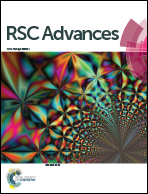Porous lithium cobalt oxide fabricated from metal–organic frameworks as a high-rate cathode for lithium-ion batteries†
Abstract
Porous materials have many applications, such as energy storage, as catalysts and adsorption etc. Nevertheless, facile synthesis of porous materials remains a challenge. In this work, porous lithium cobalt oxide (LiCoO2) is fabricated directly from Co-based metal–organic frameworks (MOFs, ZIF-67) and lithium salt via a facile solid state annealing approach. The temperature affect on the microstructure of LiCoO2 is also investigated. The as-prepared LiCoO2 shows a uniform porous structure. As a cathode for a lithium-ion battery (LIB), the LiCoO2 delivers excellent stability and superior rate capability. The as-prepared porous LiCoO2 delivers a reversible capacity of 106.5 mA h g−1 at 2C and with stable capacity retention of 96.4% even after 100 cycles. This work may provide an alternative pathway for the preparation of porous materials with broader applications.



 Please wait while we load your content...
Please wait while we load your content...